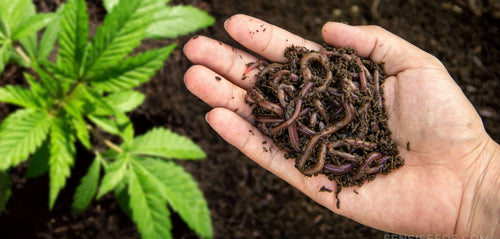#46: Exploring CBN: The Sleep-Inducing Compound in Cannabis
#46: Exploring CBN: The Sleep-Inducing Compound in Cannabis
Picture a world rich in diversity, complexity and mystery - a world that has been part of human history for centuries, yet continues to unfold new secrets. This is the world of cannabis - a plant with many uses, both therapeutic and recreational.
Composed of hundreds of active compounds, that include cannabinoids, terpenes, and flavonoids, the plant has long been used to treat a variety of ailments, ranging from chronic pain and inflammation to anxiety and depression. Many of these compounds have already been identified and their effects on the body are well known. However, one particular cannabinoid, cannabinol (CBN), is believed to hold a special property - its ability to induce sleep and provide relief from insomnia.
CBN is believed to be the product of the breakdown of tetrahydrocannabinol (THC). As THC ages, it breaks down into a variety of compounds, including CBN. This means that the more aged the cannabis, the higher its CBN content. While there have yet to be any large-scale clinical trials to fully explore its effects on humans, numerous anecdotal reports point to its efficacy in treating insomnia.
As the world struggles with sleep disorders and the side effects of synthetic sleep aids, CBN may provide an all-natural solution. With its potential for helping to regulate sleep cycles, CBN may offer a safe, natural alternative to traditional sleep medications. So, let's explore CBN and the unique role it plays in cannabis.
Cannabinoids: Unlocking the mysteries of cannabis diversity
Cannabis is a complex plant with over 100 different identified cannabinoids, each with distinct properties and effects. The most well-known among these are Tetrahydrocannabinol (THC) and Cannabidiol (CBD). Cannabinoids interact with the body's endogenous cannabinoid receptors, known as CB1 and CB2, to produce physiological effects.

THC is the primary psychoactive component in cannabis. This means it's the compound responsible for the euphoric "high" associated with recreational cannabis use. THC works by binding to the CB1 receptors in the brain, leading to feelings of euphoria and relaxation. Its medicinal benefits include alleviating symptoms such as pain, nausea, and appetite loss.
The second major cannabinoid, CBD, is non-psychoactive and interacts with the body's CB2 receptors, which are located outside the brain and throughout the body. This interaction produces therapeutic effects such as pain relief, anti-inflammation, and anxiety reduction.
In addition to THC and CBD, there are several other cannabinoids found in cannabis. These include Cannabigerol (CBG), Cannabichromene (CBC), and our focus today, CBN. Each of these compounds has its own unique characteristics and benefits, providing an array of therapeutic potential. Understanding their individual properties and how they work together is key to unlocking the potential of cannabis.
Aging cannabis and CBN: The science of better sleep
CBN is often referred to as the "sleepy" cannabinoid due to its reputed sedative effects. While further research is needed to fully understand its effects, the limited studies that were conducted suggest that CBN might induce drowsiness and prolong sleep time.
The mechanism by which CBN works to induce sleep is still being studied. However, it's believed that CBN mainly interacts with the endocannabinoid's CB2 receptors, leading to a feeling of relaxation and ultimately helping to initiate sleep. The effects are believed to be more mild than those of THC, with little risk of side effects or addiction potential.
Unlike THC and CBD, CBN is not found in abundance in fresh cannabis plants. Instead, CBN is primarily found in aged or oxidized cannabis. Cannabis that has been left out in the open for an extended period will naturally degrade and produce CBN. As such, products that have been made with aged cannabis can be a great source of CBN.
Another distinguishing factor of CBN is its mild nature. Studies suggest that CBN is only mildly psychoactive, if at all. This makes it a great option for those looking to experience the potential therapeutic benefits of cannabis without the accompanying "high".
When used in combination with other cannabinoids, such as THC and CBD, CBN has the potential to provide even greater therapeutic relief. For instance, CBN and CBD synergistically enhance each other's calming effects, making them an effective treatment for anxiety and insomnia.
Here are some of its reported therapeutic benefits:
• May provide sedating and calming effects
• Can reduce inflammation and muscle spasms
• May help to relieve anxiety and stress
• May help to stimulate appetite
• Could provide relief from pain
• Protects against aging brain cells
• Acts as an anti-bacterial and anti-fungal agent
Overall, CBN is gaining attention as an alternative to the traditional compounds found in cannabis. With its wide-ranging potential benefits, further research into CBN is necessary to uncover its full therapeutic power. What we do know is that it shows promise as an effective yet gentle option for those seeking relief from a variety of ailments.
Choosing your adventure: Ways to experience CBN
As consumers become more aware of CBN, many are eager to try it out. But how exactly do you consume CBN? There are a few ways to get your daily dose of CBN:
Oils: The most common method of consumption is through oil tinctures. CBN oil can be taken sublingually, allowing it to be absorbed directly into the bloodstream for fast-acting effects.
Capsules: These are another popular choice for those who prefer precise dosing and convenience. Capsules allow you to take CBN on the go, with effects that can last up to 8 hours.
Edibles: CBN can also be found in edible form such as gummies, chocolates, and other infused food items. This discreet and convenient option provides slow-release benefits over a longer duration.
Finding your CBN sweet spot: Dosage tips and recommendations
As with all cannabinoids, the ideal dosage of CBN can vary greatly depending on the individual. Factors such as your body weight, metabolism, and reason for use all play a role in determining the right dosage. As a general rule, it's best to start with a small dose and gradually increase until you find what works best for you.
If you're using CBN for its sleep-promoting effects, it's recommended to take it around 1 hour before bed to allow the compound time to take effect. Taking it too late in the evening or close to bedtime can increase alertness, making it difficult to fall asleep.
A safe and effective rule of thumb is to start with a low dose (2-5 mg) and increase gradually as needed. As with any compound, there are potential side effects associated with CBN. These can include dry mouth, dizziness, low blood pressure, and nausea. Listen to your body and adjust dosage or method of consumption as needed. Speak to your healthcare provider for more advice.
The future of CBN: What lies ahead
As more people seek natural alternatives for health and wellness, the demand for cannabinoids like CBN is likely to grow. Furthermore, as scientific research into CBN continues to advance, we can expect to uncover even more about the potential benefits and applications of CBN. This could lead to more effective, personalized dosing strategies and potentially even new treatment options for a variety of conditions. While there's still much to learn, one thing is clear: CBN is poised to play a significant role in the future of natural health and wellness.
Back to all posts












